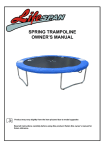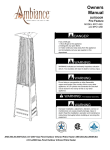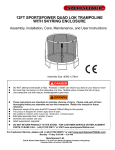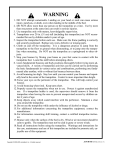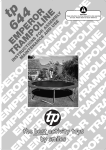Download 12” Trampoline & Safety Netting SKU# SKY1767
Transcript
12” Trampoline & Safety Netting SKU# SKY1767 ASSEMBLY MANUAL INTRODUCTION Before you begin to use this trampoline, you must read all the information in this manual. Just like any other type of physical recreational activities, participants can be injured. To reduce the risk of injury be sure to follow the appropriate safety rules and tips. • Misuse and abuse of this trampoline is dangerous and can cause serious injury! • Trampolines are rebounding devices which propel the performer to unaccustomed heights through a variety of movements. Always use caution when playing on a trampoline. • Inspect the trampoline before each use. • Proper assembly, care and maintenance of product, safety tips, warnings, and proper techniques in jumping and bouncing are all included in this manual. All users and supervisors must read and familiarize themselves with these instructions. Anyone who chooses to use this trampoline must be aware of their own limitations in regards to performing various jumps and bounces with this trampoline. Initially, you should get accustomed to the feel and bounce of trampoline. The focus must be on your body position and you should practice each fundamental bounce until you can do each skill with ease and control. Always learn the simplest bounce first and be consistent with the control of your bounce before moving on to more difficult and advanced bounces. Do not bounce recklessly on the trampoline, emphasis must be made on good control and the mastering of various bounce techniques. NO MORE THAN ONE PERSON IS ALLOWED ON THE TRAMPOLINE! MULTIPLE JUMPERS INCREASES THE RISK OF INJURY RESULTING FROM MID-AIR COLLISIONS. DO NOT PERFORM SOMERSAULTS (FLIPS) AS THIS WILL INCREASE THE CHANCES OF LANDING ON YOUR HEAD OR NECK, CAUSING PARALYSIS OR EVEN DEATH. 1 TRAMPOLINE GUIDELINES 1. GENERAL INSTRUCTIONS 1.1 PURPOSE • The product is intended for home/domestic use only and is not suitable for professional or medical uses. • The maximum weight is 330lbsz. Overloading the trampoline above the recommended user weight will cause damage to the trampoline which is not covered by the warranty. 1.2 DANGER FOR CHILDREN • Do not let unsupervised children near this product. Carry out the necessary safety precautions and supervise all trampoline activities. Be aware that the packaging material is not suitable for children. There is a danger of suffocation! • Trampolines over 51cm (20 inches) in height are not recommended for children under 6 years of age. Children do not recognize the potential dangers from this product. Keep children away from this product, it is not a toy. The product has to be stored out of reach of children and pets. 1.3 ATTENTION – PRODUCT DAMAGES • Do not alter the product. Only use original spare parts. Repairs should only be carried out by qualified technicians. Improper repairs can compromise the safety of your trampoline. Use this product only as described in this manual. • Protect the product against humidity and high temperatures. 1.4 ADVICE FOR THE ASSEMBLY • The assembly of the product must be done carefully by at least two able-bodied adults. IF in any doubt, ask a technically qualified person. • Before you start assembling the trampoline, read all the instructions in this manual. • Remove all packaging materials and lay down all parts on a free space. This gives you an overview and simplifies the assembly procedure. • Check the parts list that no parts are missing. Dispose of the packaging material when the assembly is completed. • Beware that when using tools or doing technical work, there is always a risk of injury. Please use gloves to protect your hands during assembly. • Create a danger free environment, for example: do not let tools lie around the workspace. Store the packaging material in a way that cannot cause any danger. Foils and plastic bags are dangerous for children (danger of suffocation)! • After installing the product according to the instruction manual, please make sure that all screws, bolts, and nuts are correctly installed and tightened and that all joints are tightly fixed. • A clearance space of at least 7.3m is necessary above the trampoline. An appropriate clearance must be kept between the trampoline and possible sources of danger, such as electric cables, tree branches, playing devices, swimming pools, and fences. • Never set up the trampoline in rainy, windy, or stormy conditions, especially lightning conditions. It is recommended that the trampoline be taken apart and stored in bad weather. • The metal frame of the trampoline will conduct electricity. Lightning, extension cords and all electrical equipment must never be allowed to come in contact with the trampoline. • The trampoline must always be used in a well-lit area. • DO NOT place any objects under the trampoline. 2 TRAMPOLINE GUIDELINES CONT. 1.5 ADDITIONAL TIPS • For additional stability you can place sand bags on the trampoline legs, this will prevent the trampoline from tipping over in the event of any sideward force. • Do not use during pregnancy or if you suffer from high blood pressure. • Jump with bare feet. Do not wear shoes, this will damage the jumping mat which is not covered by the warranty. • Do not put cigarettes, pets, sharp objects, or any other foreign objects on the trampolines. • Do not use the trampoline whilst under the influence of alcohol or drugs. • Do not sit or learn on cover pads as it needs to be flexible so it can move with the jumping mat. Please do not allow small children to pull themselves up the trampoline by using the cover pads. Tears in stitching caused by obstruction frame pads are not covered by warranty. • Place trampoline on level ground, preferably on grass. Locating the trampoline on hard surface will add stress to the frame and overtime causes damage which is not covered by the warranty. Placing the trampoline on an uneven surface may result in the trampoline tipping over. • Do not expose the trampoline to direct contact with open flames. • Do not use if trampoline is wet. • Trampoline should be tied down with anchors during windy conditions or dismantled and stored away. (Anchors not included). WARNING 1. Please ensure that the Safety Enclosure Net Zipper is 100% closed and all three entrance hooks are re-hooked before jumping. 2. Do not intentionally jump into the safety net. It is only designed to stop persons from falling off the trampoline. Intentionally jumping into the safety net may cause the trampoline to tip over, or may damage your net. Abuse of the safety net is considered negligent use which is not covered by the warranty. Please refer to the disclaimer. 3 TRAMPOLINE GUIDELINES CONT. 2. SAFETY INSTRUCTIONS FOR TRAMPOLINES • All users of the trampoline need a supervisor, regardless of the age and the experience of the user. Safety instructions must be considered and obeyed. • Somersaults must be avoided. Incorrect landings on the trampoline can lead to injuries, particularly to the back, neck or head. Injuries may include paralysis, or even death. • Only one person should use the trampoline at a time. Multiple users on the trampoline will increase the risk of collision. • The trampoline has to be examined for damaged, wearing, or defective parts before each usage, as it can impair the overall safety of the trampoline. The damaged, wearing, or defective parts should be replaced immediately, in the meantime the trampoline must be restricted from access. • No clothes with hooks or parts may be carried when jumping on the trampoline, in order to avoid hooks getting caught. • The trampoline must be set up only on a flat ground and non-slippery surface. • Strong winds can blow the trampoline away. If strong winds are predicted, the trampoline must be moved to a protected place, and taken apart, or fastened to the ground with cords and herrings. At least three anchorages are necessary. • Try to avoid moving the assembled trampoline, because it could bend during transportation. Should it be necessary to move the trampoline, please consider the following: At least four people must be evenly spaced around the frame to lift the trampoline off the ground. The trampoline must be carried horizontally, and if the frame shifts position use four people to draw the trampoline in shape. • Trampolines are jumping devices, enabling the user to jump to unusual heights as well as into a multiplicity of body movements which can lead to injury. • It is the responsibility of the owner or the supervisor to guarantee that all users of the trampoline are informed sufficiently of all warning references and safety instructions. • Never use it near water and keep sufficient space around it as a safety precaution. • Beware of moving parts, which could catch your arms and legs. • Do not stick any foreign objects into the trampoline. • Do not allow anyone or any object to go under the trampoline whilst someone is jumping on the mat. The jumping mat is flexible and the downwards force created by someone jumping can cause serious injury to a person. • Implement all safety rules and make yourselves familiar with the information in the user manual. • The trampoline can be only used if the jumping mat is clean and dry. Worn or damaged jumping mats should immediately be replaced. • Objects, which could be dangerous to the user, should be vacated from the area. • Avoid unauthorized and unsupervised use of the trampoline. • Do not use the trampoline under influence of alcohol or drugs (including medicine). • Learn the fundamental jumping techniques thoroughly, before trying difficult jumps. For more information, see section – Fundamental Bounce Techniques • Climb on the trampoline. Do not jump on it directly. Do not use the trampoline as a jump board for other articles. For more information, see section - Accident Categories: Mounting and Dismounting For further information or exercise documents, you can turn to a trained trampoline teacher. 4 TRAMPOLINE GUIDELINES CONT. 2.1 ACCIDENT CATEGORIES Somersaults: A landing on the head or neck, even if it happens in the center of the trampoline, increases the risk of neck and back injuries which can lead to paralysis and sometimes death. This can occur if the user makes an error and falls forward or backward. No somersaults should be attempted on the trampoline! Multiple Users on the Trampoline: The probability of an injury increases if more than one person jumps on the trampoline and loses control of their jump. Users can collide, fall down from the trampoline and land incorrectly on the jumping mat and on each other. Generally, the smallest or lightest person is at higher risk of getting injured by bigger or heavier individuals. Mounting and Dismounting: Be very careful when getting on and off the trampoline. DO NOT mount the trampoline by grabbing the cover pads, stepping onto the springs, or by jumping onto the mat of the trampoline from any object (deck, roof, or ladder). DO NOT dismount by jumping off the trampoline and landing on the ground, regardless of the makeup of the ground. IF small children are playing on the trampoline, they may need assistance in mounting and dismounting. To mount a trampoline, users should always place their hands on the frame and use this to climb up and down, then stand on the jumping mat avoiding the cover pads as much as possible. To descend, users have to go to the exterior of the jumping mat, bend forwards and put their hands on the frame, then step from the mat to the ground or ladder. Striking the Frame or Springs: When playing on the trampoline, stay in the center of the mat. This will reduce your risk of getting injured by landing on the frame or springs. Always keep the cover pads completely covering the frame and springs of the trampoline. Try to avoid stepping or jumping onto the cover pads. Loss of Control: When users lose control of their jump, they can land incorrectly on the jumping mat, land on the frame, the cover pads or even fall off from the trampoline. A controlled jump is one where the jumper lands and jumps from the same spot. Before difficult jump maneuvers are practiced, the basic controlled jump should be mastered perfectly. If the jumper is fatigued or attempts a maneuver which exceeds their abilities, there is a danger of losing control. In order to regain control of the jump and land correctly, the braking maneuver should be performed where knees should be completely bent upon landing. Under Influence of Drugs or Alcohol: The probability of an injury arises if the user is under the influence of alcohol or drugs. These substances impair the response time, judgment, special awareness, the overall physical coordination and the motor functions of the concerned user. Foreign Objects: DO NOT use the trampoline if there are pets, other people, or objects underneath the trampoline. This will increase the chances of injury occurring. DO NOT hold any foreign objects in your hands and DO NOT place any foreign objects on the trampoline while anyone is playing on it. Please be aware of what is overhead when you are playing on the trampoline. Tree limbs, electrical wires, or other objects located above the trampoline will increase the chance of injury. Limiting Access: When the trampoline is not in use, always store the access ladder in a secure place so that unsupervised children cannot play on the trampoline. 5 TRAMPOLINE GUIDELINES CONT. Poor Maintenance of the Trampoline: A trampoline in poor condition will increase your risk of getting injured. Please inspect the trampoline before each use for bent steel tubes, torn mat, loose or broken springs, and overall stability of the trampoline. The trampoline should be examined before each use. Worn or damaged parts must be replaced immediately. Defective trampolines must be restricted from use until repaired. Weather Conditions: Please be aware of the weather conditions when using the trampoline. A wet jumping mat is too slippery for safe jumping. Gusty or high winds can cause jumpers to lose control. In order to lower the probability of an injury, the trampoline should be used under suitable weather conditions only. Limiting Access: When the trampoline is not in use, always store the access ladder in a secure place so that unsupervised children cannot play on the trampoline. Weather Conditions: Please be aware of the weather conditions when using the trampoline. A wet jumping mat is too slippery for safe jumping. Gusty or high winds can cause jumpers to lose control. In order to lower the probability of an injury, the trampoline should be used under suitable weather conditions only. 2.2 METHODS OF ACCIDENT PREVENTION Role of the User in Preventing Accidents: A basic knowledge of the trampoline by the user is a must for safety. All users must first learn a low, controlled bounce and then learn the basic landing positions and combinations before proceeding to intermediate skills. Jumpers must understand why they have to master “control” before they can start thinking about other moves. A controlled jump is when you land and take off from the same location. See section – Fundamental Bounce Techniques. For further information or additional instructional materials, contact a certified trampoline instructor. Role of the Supervisor in Preventing Accidents: The supervisor needs to understand and enforce all safety rules and guidelines. It is the responsibility of the supervisor to provide knowledgeable advice and guidance to all jumpers of the trampoline. If supervision is unavailable or inadequate, the trampoline could be stored in a secure place, disassembled to prevent unauthorized use, or covered with a heavy tarpaulin that can be locked or secured with lock or chains. The supervisor is also responsible to ensure that the safety placard is placed on the trampoline and that jumpers are informed of these warnings and instructions. 3. IMPORTANT ADVICE FOR USAGE • • • • • • All users need to be supervised, regardless of skill level or age. Users must practice and perfect all the fundamental bounce techniques. A controlled jump is a jump where your take off point and landing point is the same spot on the mat. Do not jump or bounce for prolonged periods of time because fatigue can increase the chances of injury. The appropriate clothing must consist of a t-shirt, shorts or sweats, and regulation gymnastics shoes, thick socks, or bare feet. If you are just beginning, you may want to wear long sleeve shirts and pants to protect against scrapes and abrasions until you master correct landing positions and form. Complicated jumping maneuvers are not recommended without the supervision of a certified trampoline instructor. All fundamental jumping skills should be learned with normal jumps. Supervisors should emphasize jump techniques instead of the jumping height. Users may not jump alone and unsupervised on the trampoline. See section - Fundamental Bounce Techniques. 6 TRAMPOLINE GUIDELINES CONT. 4. TRAMPOLINE PLACEMENT The minimum overhead clearance required is 7.3m( 24’). In terms of horizontal clearance, please ensure that no hazardous objects are near the trampoline such as tree limbs, electrical power wiring, walls, fences, etc. For safe use of the trampoline, please be aware of the following when selecting a place for your trampoline: • • • • Make sure it is placed on a level and non-slip surface. The area is well lit. There are no obstructions beneath the trampoline. There are no obstructions above the trampoline, such as tree limbs or electrical wiring. 5. MAINTENANCE Inspect the product regularly for damages, abrasion, or wearing parts and immediately notify authorized dealers for any replacement parts. If damages occur before the warranty’s expiration date, please keep your sale invoice ready. These trampolines are all galvanized against rust. However overtime slight rusting may appear between joints and under the padding, you can prevent this rust from developing by applying petroleum jelly to the spring holes and between the joints. Regular maintenance against rust will extend the frame life. 6. CLEANING Do not use any abrasive cleansers for cleaning. Use a soft, damp cloth to eliminate dirt and dust. 7. ADVICE FOR THE DISPOSAL This product is delivered with packaging to protect it from damages during transport. Most of the packaging material is recyclable, so please dispose of these materials accordingly. 7 TRAMPOLINE PARTS LIST A. Top Rails x 8 B. Frame Cover x 1 C. Jumping Mat x 1 D. Leg Base x 4 E. Leg Extensions x 8 F. Springs x 72 G. Spring Tool x 1 8 H. Protective Gloves x 1 TRAMPOLINE ASSEMBLY (Refer to TRAMPOLINE PARTS LIST for identification of parts.) WARNING: Two adults in good physical condition are required for the following assembly. For your safety, you should wear proper shoes and clothing. Failure to follow the instructions and warnings may results in injury. Note: It is recommended that you wear the provided protective gloves during assembly to prevent any injury. 1. Lay out all the trampoline parts in groups, as shown above. 2. Attach the two leg extensions to a leg base. Repeat for all leg supports. 3. Attach all the top rails to form a large circle. Joining the last link may require two people. 4. Attach all the leg supports you assembled in STEP 2 to the top frame. 9 TRAMPOLINE ASSEMBLY Fig. 1 5. At this stage the trampoline should look like the picture above. Refer to FIGURE 1 above, for help. 6. With the stitching facing down, lay the jumping mat inside the frame and attach a spring into one of the triangle rings on the mat. Then attach the other end of the spring to the frame. 7. Repeat STEP 6 directly across where you attached the first spring. Then attach two more springs half the distance between the first two springs, directly across from each other. This will ensure equal tension is distributed between the springs. 8. Repeat process for the remaining springs. Use the spring tool, as shown above. 10 9. Springs under heavy tension may require adjacent springs to be attached at every four or five holes, so the spring tension is distributed equally. 10. Attach the remaining springs until all springs are attached to the frame. 11. Lay the cover pads on the outer edge so the springs are covered. 12. Tie all the cover pad’s strings onto the top rail of the trampoline. 13. Proceed to the TESTING THE TRAMPOLINE section of this manual before jumping on the trampoline. 11 SAFETY ENCLOSURE PARTS LIST A. Quick Clamp x 16 B. Upper Pole x 8 C. Lower Pole x 8 D. Safety Netting x 1 E. Ladder x 1 F. Tool x 1 12 SAFETY ENCLOSURE ASSEMBLY (Refer to SAFETY ENCLOSURE PARTS LIST for identification of parts.) WARNING: Two adults in good physical condition are required for the following assembly. For your safety, you should wear proper shoes and clothing. Failure to follow the instructions and warnings may results in injury. Note: It is recommended that you wear the provided protective gloves during assembly to prevent any injury. 1. Slide the foam tube over a pole, as shown above. Repeat for all poles. (This may already be assembled). 2. Insert the lower pole into the upper pole. Repeat for all lower and upper poles. 3. Place the safety enclosure mesh on the trampoline tidily, as shown above, ready for the next step. 4. Slide the enclosure poles you assembled in STEP 2 into the safety enclosure mesh pole jacket. 13 5. Repeat STEP 4 for all the enclosure poles. Make sure you insert the poles firmly into the jacket. 6. You may need another person to hold the enclosure pole in place whilst you clamp the pole to leg supports in the next step. 7. Use the quick clamp to secure the enclosure pole to the lower hole of the leg extension and the hole of “U” shape leg. 8. Use the quick clamp to secure the enclosure pole to the upper hole of the leg extension and the hole of the top rail’s welded tube. 9. Repeat STEP 6 to STEP 8 for the remaining poles. 10. When released, Safety enclosure hooks, should look like the above photo. 14 11. Attach the hooks to the nearest triangle ring of the mat. If you find it difficult to attach the hooks to the triangle rings go to STEP 12. 12. Attach the hook to the ring portion of the spring. 13. Zip the entrance close, and fasten all the entrance hooks. Supervisors must re-zip and re-hook all the entrance hooks securely before jumping begins. 14. Proceed to the Testing the Trampoline section of this manual before jumping on the trampoline. 15. To add the Ladder to the trampoline, hook onto Top Rail. 15 TESTING THE TRAMPOLINE After assembling the trampoline, it is important that you perform the following safety checks: • • • • • • Using a screw driver, check if all the screws are tightly secured. Look underneath the trampoline and check all the springs are hooked securely to the frame and triangle rings. Move the trampoline around and check the sturdiness of the frame. Using your two hands, put your body weight on one section of the trampoline and release to check that the floor is even. Inspect the cover pads and check if they completely cover the springs and frame. Make sure the strings of the pads are tied securely. ENCLOSURE NET SAFETY CHECKS: • • • • Hold onto pole net jacket and check that all the enclosure poles are sturdy by shaking it. Check the enclosure net and pole jackets for any tearing in the stitching or material. Check the enclosure net zipper and entrance hooks functions properly. Check to see if all safety enclosure hooks are attached to the triangle ring underneath the trampoline. Once all the checks are performed and the trampoline has passed all the initial tests (above), have one person test the trampoline by jumping on the center continuously for 5 minutes. If the trampoline feels sturdy then your trampoline passes the test. Congratulations, you have completed the trampoline safety test. Remember to abide by all the safety rules. Have fun, and play safe! PLEASE NOTE: AS ALREADY MENTIONED IN THE INSTRUCTION MANUAL, CERTAIN WEAR AND TEAR PARTS HAVE TO BE REPURCHASED FROM YOUR SUPPLIER. 16 FUNDAMENTAL BOUNCES TECHNIQUES All trampoline users are recommended to understand and perfect these fundamental bounces. THE BASIC BOUNCE • • • • Start from standing position, feet shoulder width apart and with head up and eyes on mat. Swing arms forward and up and around in a circular motion. Bring feet together while in mid-air and point toes downward. Keep feet shoulder width apart when landing on mat THE BRAKING MANEUVER • • • Occasionally the user may lose control of their jump and bounce wildly. Performing the braking maneuver will allow the user to regain control of the jump and their balance. Start with a basic bounce. As you land, bend your knees sharply and this will allow you to stop your jump. THE HANDS AND KNEES BOUNCE • • Start with a low controlled basic bounce. Land on your hands and knees keeping your back straight. Emphasis should be directed at a good four-point landing, and not on jumping height. KNEE BOUNCE • Start with a low controlled basic bounce. • Land on your knees keeping back straight, body erect, and use your arms to maintain balance. • Bounce back to the basic bounce position by swinging your arms up. SEAT BOUNCE • Land in a flat sitting position. • Place hands on mat beside your hips. • Return to erect position by pushing with your hands. 17 18




















